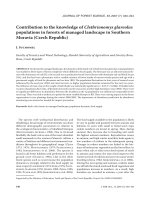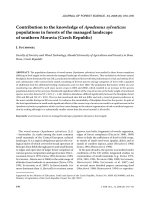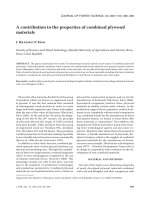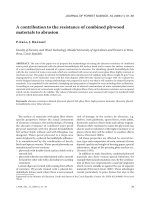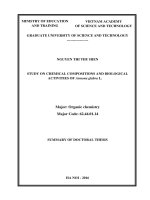Contribution to the study on chemical constituents from the leaves of Cassia alata l., (Caesalpiniaceae)
Bạn đang xem bản rút gọn của tài liệu. Xem và tải ngay bản đầy đủ của tài liệu tại đây (726.41 KB, 6 trang )
Science & Technology Development, Vol 16, No.T2- 2013
Contribution to the study on chemical
constituents from the leaves of Cassia
alata l., (Caesalpiniaceae)
Ngo Thi Thuy Duong
Hoang Thi Chinh
Thong Sui Din
Truong Le Hung Phong
Phan Nhat Phuong
Pham Quoc Quynh
Nguyen Tra Thanh Truc
Ton That Quang
University of Science, VNU-HCM
(Manuscript received on March 20st 2013, accepted on September 9th 2013)
ABSTRACT
Six compounds were isolated from the
leaves of Cassia alata L. (Caesalpiniaceae),
including: aloe emodin (1), aloe emodin-8-Oβ-glucoside (2), rhein methyl ester (3),
kaempferol (4), 4-hydroxybenzoic acid (5)
Key words: Cassia alata, anthraquinone.
Trang 26
and phytol (6). Rhein methyl ester (3) was
first isolated from the Cassia genus. Their
chemical structures were elucidated by
spectroscopic analysis.
TAẽP CH PHAT TRIEN KH&CN, TAP 16, SO T2 - 2013
INTRODUTION
Cassia alata L. (= Senne alata L.) (Fig. 1)
belongs to the Caesalpiniaceae family. It is native
to Central America and has been introduced into
many tropical countries and islands. In Vietnam,
it is widely distributed in the Middle and the
South [1, 2, 3, 4].
Cassia alata L. appears in a considerable
number of published ethnopharmacological
studies. It is laxative, antifebrile, antiseptic and
diuretic. It has been used to cure many diseases:
skin rashes, constipation, herpes circine,
digestive ailments [1, 2, 3, 4].
Fig. 1. Cassia alata L.
MATERIALS AND METHODS
General
NMR spectra were obtained on a Bruker
Avance 500 NMR spectrometer. Mass spectra
were taken on a high resolution ESI Bruker
Daltonics micrOTOF-Q II 10187 mass
spectrometer. Chromatography column was
carried out on Kieselgel 60 (63200 mesh)
Merck.
Thin-layer
chromatography
was
performed on Merck 25DC-Alufolien 20ì20cm
Kieselgel 60 F254 plates. 1D and 2D-NMR were
recorded on Bruker Avance 500 (500 MHz for
1
H-NMR and 125 MHz for 13C-NMR).
Plant material
Plants were collected in Binh Chanh district,
Ho Chi Minh City and was identified by
pharmacist Phan Duc Binh, the deputy editor of
the Medicine and Health semi-monthly
magazine.
Extraction and isolation
Plants were washed, dried, ground into
powder (2.1 kg) and exhaustedly extracted by
methanol at room temperature. After evaporating,
the methanolic solution gave crude extract (525
g). This extract was partitioned successively in
petroleum ether, chloroform, ethyl acetate and
butanol to give corresponding extracts. Petroleum
ether fraction and ethyl acetate fraction were
chromatographied repeatedly to afford six pure
compounds. Petroleum ether fraction gave (3),
(6) and ethyl acetate fraction gave (1), (2), (4),
(5).
Aloe emodin (1): lightly orange needles. 1HNMR (500 MHz, DMSO-d6): 11.96 (2H, br, OH), 7.82 (1H, t, J = 8.0 Hz, H6), 7.74 (1H, d, J
= 7.5 Hz, H5), 7.71 (1H, brs, H4), 7.40 (1H, d, J
= 8.0 Hz, H7), 7.31 (1H, brs, H2), 5.62 (2H, t, J
= 6.0 Hz, 3-CH2OH). 13C-NMR (125 MHz,
DMSO-d6): 161.6 (C1), 120.7 (C2), 153.7 (C3),
117.1 (C4), 119.3 (C5), 137.3 (C6), 124.4 (C7),
161.3 (C8), 191.6 (C9), 181.5 (C10), 133.4
(C11), 115.9 (C12), 114.5 (C13), 133.1 (C14),
62.0 (C15).
Aloe emodin-8-O--glucoside (2): orange
needles. 1H-NMR (500 MHz, Pyridine-d5): 13.34
(1H, br, -OH), 8.11 (1H, brs, H4), 8.04 (1H, d, J
= 8.0 Hz, H5), 7.99 (1H, d, J = 8.0 Hz, H7), 7.67
(1H, brs, H2), 7.60 (1H, t, J = 8.0 Hz, H6), 5.00
(3-CH2OH), 5.81 (1H, d, J = 7.5 Hz, H1), 4.60
(1H, dd, J = 12.0 Hz, J = 2.5 Hz, H6a), 4.57
(1H, t, J = 8.5 Hz, H2), 4.43 (1H, t, J = 7.5 Hz,
H4), 4.42 (1H, dd, J = 12.5 Hz, J = 5.5 Hz,
H6b), 4.38 (1H, t, J = 8.5 Hz, H3), 4.25 (1H, m,
H5). 13C-NMR (125 MHz, Pyridine-d5): 163.1
(C1), 121.4 (C2), 153.2 (C3), 116.7 (C4), 121.2
(C5), 135.0 (C6), 123.0 (C7), 159.4 (C8), 188.6
(C9), 182.6 (C10), 133.1 (C11), 116.0 (C12),
Trang 27
Science & Technology Development, Vol 16, No.T2- 2013
116.3 (C13), 127.0 (C14), 63.2 (C15), 102.7
(C1’), 74.9 (C2’), 78.4 (C3’), 71.1 (C4’), 79.4
(C5’), 62.4 (C6’).
Rhein methyl ester (3): yellow powder. HRESI-MS analysis (m/z 299.0587 [M+H]+, calcd.
for [C16H11O6+H]+ = 299,0550). 1H-NMR (500
MHz, CDCl3): 12.03 (1H, s, 1-OH), 11.97 (1H, s,
8-OH), 8.43 (1H, d, J = 1.5 Hz, H4), 7.95 (1H, d,
J = 1.5 Hz, H2), 7.89 (1H, dd, J = 7.5 Hz, J = 1.0
Hz, H5), 7.74 (1H, t, J = 8.0, H6), 7.37 (1H, dd, J
= 8.5 Hz, J = 1.0 Hz, H7), 4.00 (3H, s, -OCH3).
13
C-NMR (125 MHz, CDCl3): 163.0 (C1), 125.5
(C2), 138.1 (C3), 120.4 (C4), 120.6 (C5), 137.9
(C6), 125.1 (C7), 162.6 (C8), 193.1 (C9), 181.1
(C10), 133.7 (C11), 116.1 (C12), 134.1 (C13),
118.5 (C14), 165.1 (C15), 53.0 (C16).
Kaempferol (4): yellow needles. 1H-NMR
(500 MHz, DMSO-d6): 12.48 (1H, s, 5-OH),
10.79 (1H, s, 7-OH), 10.11 (1H, s, 4’-OH), 9.39
(1H, s, 3-OH), 8.05 (2H, d, J = 9.0 Hz, H2’ and
H6’), 6.93 (2H, d, J = 9.0 Hz, H3’ and H5’), 6.44
(1H, d, J = 2.0 Hz, H8), 6.20 (1H, d, J = 2.0 Hz,
H6). 13C-NMR (125 MHz, DMSO-d6): 146.8
(C2), 135.7 (C3), 175.9 (C4), 160.7 (C5), 98.2
(C6), 163.9 (C7), 93.5 (C8), 156.2 (C9), 103.1
(C10), 121.7 (C1’), 129.5 (C2’ and C6’), 135.7
(C3’ and C5’), 159.2 (C4’).
4-hydroxybenzoic acid (5): white needles.
H-NMR (500 MHz, acetone-d6): 7.91 (2H, d, J =
8.5 Hz, H2 and H6), 6.91 (2H, d, J = 9.0 Hz, H3
and H5. 13C-NMR (125 MHz, acetone-d6): 121.8
(C1), 131.8 (C2, C6), 115.1 (C3, C5), 161.7 (C4),
166.7 (-COOH).
1
Phytol (6): white powder. 1H-NMR
(500MHz, CDCl3): 5.41 (1H, t, J = 7.0, H2), 4.15
(2H, d, J = 6.5 Hz, H1), 2.0 – 0.7 (protons of CH,
CH2, CH3). 13C-NMR (125 MHz, CDCl3): 59.61
(C1), 123.34 (C2), 140.45 (C3), 40.04 (C4),
25.33 (C5), 36.86 (C6), 32.87 (C7), 37.55 (C8),
24.64 (C9), 37.62 (C10), 32.97 (C11), 37.48
(C12), 24.95 (C13), 39.56 (C14), 28.14 (C15),
22.85 (C16), 22.77 (C17).
Trang 28
RESULTS AND DISCUSSION
Compound (1) was obtained as lightly
orange needles. The 1H-NMR (500MHz, DMSOd6) spectrum showed the presence of five
aromatic protons. In ring A, there were three
protons at δ 7.82 (1H, t, J = 8.0Hz, H6), 7.74
(1H, d, J = 7.5Hz, H5) and 7.40 (1H, d, J =
8.0Hz, H7). In ring C, two protons broad singlet
were resonated at δ 7.71 (1H, brs, H4) and 7.31
(1H, brs, H2). A low field signals at δ 11.96 that
integrated for two protons was attributed to two
identical hydroxyl protons that were strongly
chelated to a carbonyl group. A triplet at δ 5.62,
integrated for two protons, was suggested the
presence of a hydoxymethyl group. The 13CNMR spectrum showed the signals of 15 carbons,
which included two carbonyl downfield signals at
δ 191.6 and 181.5, indicative the presence of the
chelated and nonchelated carbonyl respectively.
Based on its spectral data and by comparison
with data from the literature, 1 was assigned as
aloe emodin [5].
Compound (2) was isolated as orange
needles. Although NMR spectra of 2 were run in
pyridine-d5 (different from the solvent DMSO-d6
of 1), the structure of 2 was nearly similar to 1
with five aromatic protons: 8.04 (1H, d, J =
8.0Hz, H5), 7.99 (1H, d, J = 8.0Hz, H7), 7.60
(1H, t, J = 8.0Hz, H6) for ring A and 8.11 (1H,
brs, H4), 7.67 (1H, brs, H2) for ring C; two
chelated and nonchelated carbonyl at δ 188.6 and
182.6; one hydoxymethyl group (δH 5.00, δC
63.2). The only different is that 2 has one
chelated hydroxyl group and the second hydroxyl
group was changed to O-glucoside. Based on
HSQC and HMBC (table 1), this glucoside linked
to C8 of the aglycon moiety. From these data, 2
was identified as aloe emodin-8-O-β-glucoside.
Compound (3) was obtained as yellow
powder. The HR-ESI-MS displayed the
pseudomolecular ion peak at m/z 299.0587
[M+H]+ (calcd. for [C16H11O6+H]+ = 299.0550)
TAẽP CH PHAT TRIEN KH&CN, TAP 16, SO T2 - 2013
corressponding to the molecular formula
C16H11O6. The 1H-NMR spectrum supported the
chelated nature of two hydroxyl groups to the
carbonyl by the characteristic downfield signals
at 12.03 (1H, s, 1-OH) and 11.97 (1H, s, 8OH). A monosubstituted ring A was indicated by
the three coupled protons at 7.89 (1H, dd, J =
7.5Hz, J = 1.0Hz, H5), 7.74 (1H, t, J = 8.0, H6)
and 7.37 (1H, dd, J = 8.5Hz, J = 1.0 Hz, H7). A
disubstituted ring C was indicated by the two
coupled protons at 8.43 (1H, d, J = 1.5Hz, H4);
7.95 (1H, d, J = 1,5Hz, H2).
Table 1. The 1H-NMR (500 MHz) and 13C-NMR (125 MHz) spectra for 1 and 2
Compound (1) (DMSO-d6)
No
1
2
3
4
5
6
7
8
9
10
11
12
13
14
15
1-OH
8-OH
1
2
3
4
5
6a
6b
C
161.6
120.7
153.7
117.1
119.3
137.3
124.4
161.3
191.6
181.5
133.4
115.9
114.5
133.1
62.0
-
H (J, in Hz)
7.31 brs
7.71 brs
7.74 d (7.5)
7.82 t (8.0)
7.40 d (8.0)
5.62 t (6.0)
11.96 br
11.96 br
-
C
163.1
121.4
153.2
116.7
121.2
135.0
123.0
159.4
188.6
182.6
133.1
116.0
116.3
127.0
63.2
102.7
74.9
78.4
71.1
79.4
62.4
A three-proton singlet at 4,00 indicated the
presence of a methoxy group. The 13C NMR
spectrum showed the signals of one methyl ester
group (-COOCH3) at 165,1 and 53,0; two
chelated and nonchelated carbonyl carbons at
193,1 (C9) and 181,1 (C10); two oxygenated
aromatic carbons at 163,0 (C1) and 162,6 (C8).
The NMR spectral data of compound (3) closely
resembled the known compound rhein [6] except
the signals of one -OCH3 moiety. Besides, the
HMBC showed the correlation between the
proton of this methoxyl group with carbonyl
Compound (2) (pyridine-d5)
HSQC
HMBC
(1H13C)
H (J, in Hz)
COSY
(1H1H)
7.67 brs
4, 13
4
8.11 brs
8.04 d (8.0)
7.60 t (8.0)
7.99 d (8.0)
2, 10, 13
10, 12
7, 8
12
2
6, 7
5, 7
6, 5
5.00 overlapped
13.34 br
2, 3, 4
5.81 d (7.5)
4.57 t (8.5)
4.38 t (8.5)
4.43 t (7.5)
4.25 m
4.60 dd (12.0, 2.5)
4.42 dd (12.5, 5.5)
8
2
1, 3
2, 4
3, 5
4, 6a, 6b
5, 6b
5, 6a
ester, so compound (3) was established as rhein
methyl ester. This is the first time that rhein
methyl ester (3) was isolated from the Cassia
genus.
Comparison of 1H-NMR and 13C-NMR data
and physical data with those reported in the
literature confirmed that compounds 4 - 6 were
kaempferol (4) [7], 4-hydroxybenzoic acid (5)
and phytol (6) [8].
Trang 29
Science & Technology Development, Vol 16, No.T2- 2013
Table 2. The 1H-NMR (500 MHz) and 13C-NMR (125 MHz) spectra for 3
Compound (3) (CDCl3)
HSQC
o
N
C
1
163.0
2
125.5
3
138.1
4
5
6
HMBC
(1H→13C)
H (J, in Hz)
7.95 d (1.5)
1, 4, 15
120.4
8.43 d (1.5)
2, 10, 14, 15
120.6
137.9
7.89 dd (7.5, 1.0)
7.74 t (8.0)
7, 10, 12
8, 11
7
125.1
7.37 dd (8.5, 1.0)
5, 8, 12
8
162.6
9
193.1
10
181.1
11
133.7
12
116.1
13
134.1
14
118.5
15
165.1
16
53.0
4.00 s
15
1-OH
-
12.03 s
1, 2
8-OH
-
11.97 s
7, 8,12
Góp phần tìm hiểu thành phần hóa học
lá cây Muồng Trâu Cassia alata l.,
(Caesalpiniaceae)
Ngô Thị Thùy Dương
Hoàng Thị Chinh
Thòng Sủi Din
Trương Lê Hùng Phong
Phan Nhật Phương
Phạm Quốc Quỳnh
Nguyễn Trà Thanh Trúc
Tôn Thất Quang
Trường Đại học Khoa học Tự nhiên, ĐHQG-HCM
Trang 30
TẠP CHÍ PHÁT TRIỂN KH&CN, TẬP 16, SỐ T2 - 2013
TĨM TẮT
Từ lá cây Muồng Trâu Cassia alata L.
(Caesalpiniaceae), đã cơ lập được sáu hợp
chất, bao gồm: aloe emodin (1), aloe
emodin-8-O-β-glucosid (2), rhein metyl ester
(3), kaempferol (4), acid 4-hydroxybenzoic
(5) và phytol (6). Trong đó, hợp chất rhein
methyl ester (3) lần đầu tiên được cơ lập từ
chi Cassia. Cấu trúc của các hợp chất được
xác định bằng các phương pháp phổ
nghiệm.
Từ khóa: Cassia alata, anthraquinone.
REFERENCES
[1] Võ Văn Chi, Từ điển cây thuốc Việt Nam,
Nhà xuất bản Y Học (1997).
[2] Phạm Hồng Hộ, Cây cỏ Việt Nam, Nhà xuất
bản Trẻ (2000).
[3] Đỗ Tất Lợi, Những cây thuốc và vị thuốc
Việt Nam, Nhà xuất bản Khoa học Kỹ thuật
(1986).
[4] T. Hennebelle, B. Weniger, H. Joseph, S.
Sahpaz, F. Bailleul, Senna alata, Fitoterapia,
385 – 393 (2009).
[5] R.M.
Coopoosamy,
M.L.
Magwa,
Antibacterial activity of aloe emodin and
aloin A isolated from Aloe excelsa, African
Journal of Biotechnology 5, 1092-1094
(2006).
[6] K. Danielsen, D.W. Aksnes, G.W. Francis,
NMR study of some anthraquinones from
rhubarb, Magn Reson Chem 30, 359-360
(1992).
[7] A.S. Hamzah, N.H. Lajis, Chemical
constituents of Hedyotis herbacea, ASEAN
Review of Biodiversity and Environmental
Conservation 2, 1-5 (1998).
[8] T.T. Tong, J.Y. Chou-Hwang, An optically
active chromanone from Gynura formosana,
Phytochemistry 44, 553(1997).
Trang 31


